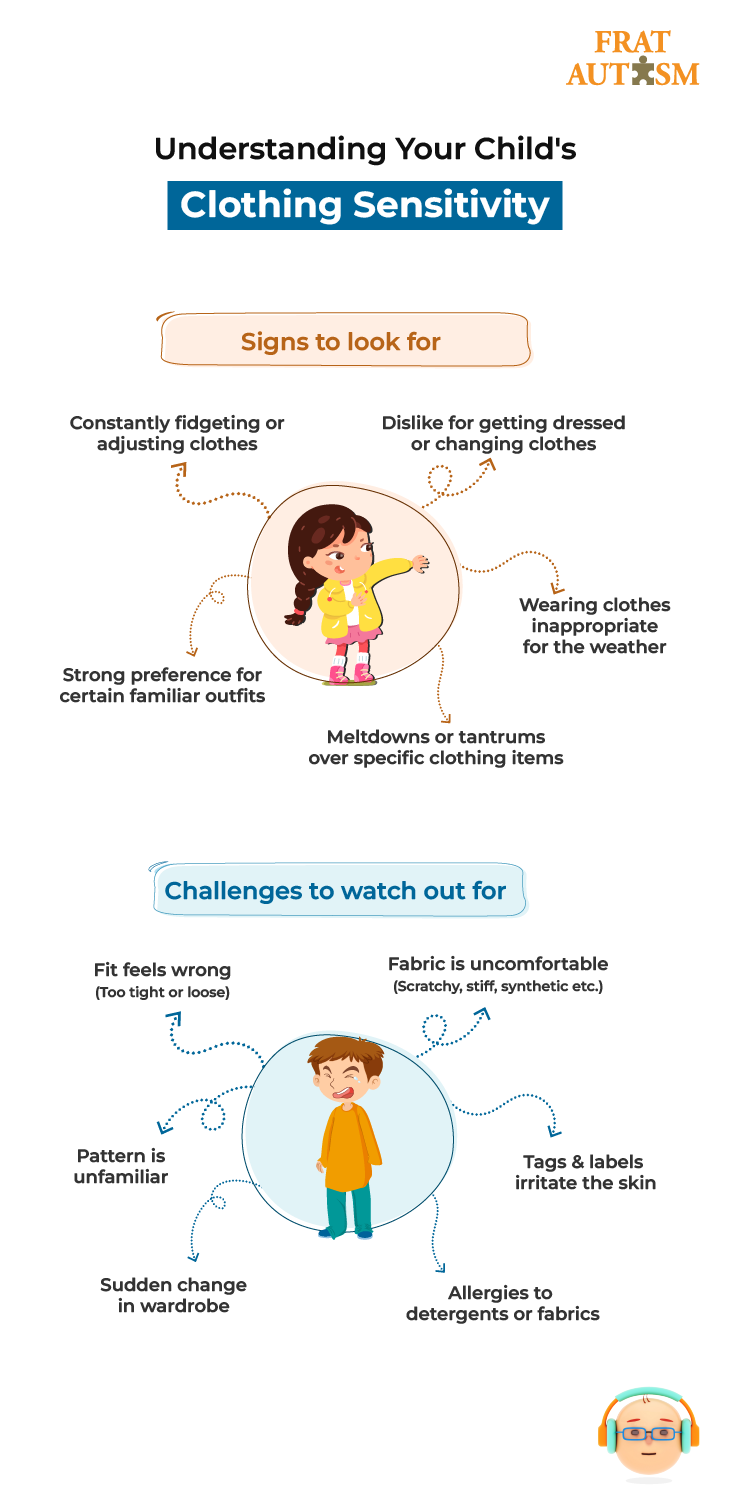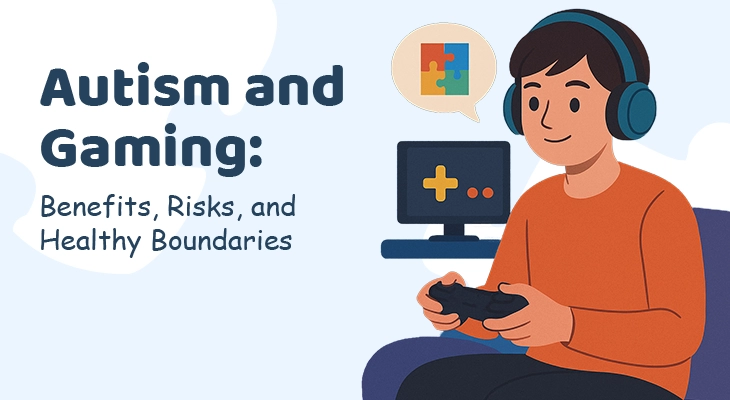What is clothing sensitivity in autism?
Autism clothing sensitivity is when certain textures, seams, or tags feel uncomfortably itchy, scratchy, or even painful on an autistic person’s skin. This can be very distracting and lead to anxiety or meltdowns.
For some autistic individuals, clothing can feel like more than just an outfit. The texture of a shirt might feel uncomfortably rough, like sandpaper against their skin. Tight waistbands or socks that bunch-up can be constricting and bothersome. Loose-fitting clothes, on the other hand, might feel floppy and distracting, always on the verge of slipping off. Even a new piece of clothing, with its unfamiliar texture and feel, can be overwhelming.
This is the reality for many autistic individuals, and it can significantly impact their daily lives. Let’s explore some ways to navigate clothing sensitivity and create a more comfortable wardrobe for autistic people.
Table of Contents
- What is clothing sensitivity in autism?
- What are the signs of clothing sensitivity in autism?
- What are the reasons behind clothing sensitivity in autism?
- What is the impact of clothing sensitivity on autistic children?
- What are the strategies for dressing a child with autism?
- Autism and undressing in public
- Conclusion
- Did You Know?
- References
What are the signs of clothing sensitivity in autism?
Here are some signs that your child might be sensitive to clothing:
- Fidgeting and Discomfort: When your child seems particularly fidgety or unfocused when wearing certain clothes, or when they are constantly playing with or adjusting their clothing, like pulling at seams or tags.
- Disinterest in Dress-Up: If your child consistently refuses to participate in dress-up games it might be due to clothing sensitivity as the idea of wearing unfamiliar textures or styles could be overwhelming.
- “Uniform” Preference: When your child insists on wearing the same outfit repeatedly, almost like a uniform. This might be indicative of their attachment to the comfort and predictability of their preferred clothes.
- Weather Inappropriate Clothing: When your child might wear clothes that are not appropriate for the weather, like insisting on long sleeves in hot weather or shorts in cold weather.

Download Download & share this infograph card in your network [Free Download]
What are the reasons behind clothing sensitivity in autism?
Clothing sensitivity is a common experience for autistic children due to a sensory processing difference called tactile defensiveness. This means they have a negative reaction to touch sensations that others might not even notice. Tactile defensiveness can manifest in two ways: hypersensitivity and hyposensitivity.
- Hypersensitivity: This is the more common form of tactile defensiveness in autism. It means an overreaction to touch that feels unpleasant because their sense of touch is on overdrive. Hypersensitivity can make even soft clothing feel rough and irritating. Sight can also play a role. Some children may find certain textures visually displeasing, which adds to the discomfort of wearing those clothes. So, the combination of a heightened sense of touch and visual sensitivities can make clothing a real source of stress for autistic children.
- Hyposensitivity: This is less common but can also occur in autism. It refers to a reduced sensitivity to touch, which can lead to a craving for stronger sensory input. For example, children with hyposensitivity might seek out rough textures like sandpaper or coarse fabrics for stimulation. They might also prefer extra tight clothing, likely to satisfy their need for constant pressure or movement.
To understand the full implications of sensory issues in autism, please read our blog on Sensory Issues and Autism: An all you need to know guide for parents & caregivers

Download Download & share this infograph card in your network [Free Download]
What is the impact of clothing sensitivity on autistic children?
Clothing sensitivity can have a significant impact on autistic children in several ways:
Discomfort and Distress
- Physical Discomfort: The most immediate impact is physical discomfort. Hypersensitivity to textures, seams, or tags can cause irritation, itching, or even pain. This can make getting dressed and wearing clothes a stressful experience.
- Emotional Distress: The discomfort can lead to emotional distress, anxiety, and meltdowns. Children may struggle to regulate their emotions when overwhelmed by unpleasant sensory input from clothing.
Challenges with Daily Activities
- Getting Dressed: Clothing sensitivity can make getting dressed a time-consuming and frustrating experience for both the child and caregiver. The child might resist putting on clothes, leading to tantrums or meltdowns.
- Social Interaction: If a child’s clothing sensitivity limits their clothing options, it can make social interaction difficult. They might feel self-conscious or uncomfortable wearing clothes that are different from their peers.
- Limited Participation: Clothing sensitivity can restrict participation in certain activities. For example, a child who dislikes wearing shoes might be hesitant to go outside or play in certain areas.
Overall Well-being
- Reduced Focus: Constant discomfort from clothing can make it difficult for children to focus on other tasks, impacting their learning and development.
- Lower Self-Esteem: Feeling limited in clothing choices can lead to feelings of isolation and lower self-esteem.
What are the strategies for dressing a child with autism?
Dressing a child with autism can be a challenge, but with some planning and creativity, you can create a smoother and more positive experience for everyone. Here are some strategies:
Building a Comfortable Wardrobe
- Keep a Clothing Journal: Track your child’s preferences for textures, materials, brands, and styles. This helps you identify comfortable clothes they’ll enjoy wearing.
- Inspect Clothing: Remove any potential irritants like tags, seams, or itchy materials before offering clothes to your child.
Making Choices Easier
- Offer Limited Choices: Reduce anxiety by providing a few pre-approved outfit options. Use visual aids like pictures if your child is non-verbal.
Prepare for Change
- Pack for the Weather: Let your child choose their outfit in the morning, but pack extra clothes to adapt to changing weather conditions.
- Introduce New Clothes Gradually: Don’t overhaul your child’s wardrobe all at once. Slowly introduce new clothes alongside familiar favorites.
Stock Up on Favorites
- Buy Duplicates: Purchase extras of your child’s favorite clothes so you can easily replace worn-out items.
- Consider Sizing Up: Buy clothes in slightly bigger sizes to accommodate growth while maintaining familiar comfort.
Autism and undressing in public
Public undressing is a behavior sometimes seen in children with autism. It is a matter of great concern for several reasons:
- Safety: Public nudity can expose a child to unwanted attention and can leave a child vulnerable to physical or emotional harm.
- Communication Challenges: Public undressing could mean the child has difficulty in communicating their needs and undressing might be their way of expressing discomfort or a desire for a change.
- Underlying Issues: Public undressing can be a sign of underlying anxieties or frustrations. It’s important to understand the root cause of the behavior.
- Inappropriate Social Norms: Undressing in public goes against societal expectations of appropriate behavior. This means that the autistic child doesn’t understand emotional or social cues. This can lead to confusion, embarrassment, and even social exclusion for the autistic child.
- Inappropriate Coping Mechanism: In some cases, public undressing might be a way for an autistic child to cope with overwhelming sensory input from clothing. However, it’s not a healthy or appropriate coping mechanism.
Conclusion
This blog explored the challenges faced by autistic individuals due to clothing sensitivity. We learned that textures, seams, tags, and even fit can cause discomfort and distress. This discomfort can lead to meltdowns, anxiety, and difficulty functioning in daily activities.
The good news is there are strategies! By keeping clothing journals, prioritizing comfort, offering choices, and planning for change, we can help autistic children build a wardrobe they can feel confident and comfortable in. Remember, patience, flexibility, and a focus on sensory needs are key.





